Qudit Challenges
 npj Quantum Information 2024 reports a comparative analysis of gate efficiency between systems composed of qubits
and higher-dimensional qudits, utilizing both analytical methods and numerical simulations. These insights provide a valuable benchmark for assessing the operational efficiency of qudit
platforms, particularly those with lower dimensionality, in comparison to established qubit systems. The study suggests that certain qudit platforms may offer advantages in gate efficiency, highlighting
their potential in advancing quantum information processing technologies.
npj Quantum Information 2024 reports a comparative analysis of gate efficiency between systems composed of qubits
and higher-dimensional qudits, utilizing both analytical methods and numerical simulations. These insights provide a valuable benchmark for assessing the operational efficiency of qudit
platforms, particularly those with lower dimensionality, in comparison to established qubit systems. The study suggests that certain qudit platforms may offer advantages in gate efficiency, highlighting
their potential in advancing quantum information processing technologies.
Direct determination of the high-order ligand field parameters
 In this work, Nature Comm 2023, we provide access to an experimental technique that allows
the direct determination of high-order ligand field parameters by measuring the magnetisation, while simultaneously performing multifrequency EPR studies.
In this work, Nature Comm 2023, we provide access to an experimental technique that allows
the direct determination of high-order ligand field parameters by measuring the magnetisation, while simultaneously performing multifrequency EPR studies.
Aromaticity-driven regioselectivity
 In Nature Chemistry 2023 we investigated how aromaticity affects the reactivity of
alkyne-substituted porphyrin molecules during coupling reactions on a Au(111) surface. We show a substantially lower reactivity of carbon atoms that are stabilized by the aromatic diaza[18]annulene pathway of free-base porphyrins.
In Nature Chemistry 2023 we investigated how aromaticity affects the reactivity of
alkyne-substituted porphyrin molecules during coupling reactions on a Au(111) surface. We show a substantially lower reactivity of carbon atoms that are stabilized by the aromatic diaza[18]annulene pathway of free-base porphyrins.
Effective Photon-Spin Interface for Quantum Computing
 Published in Nature 2022 we present a mononuclear Europium (III) complex, in which the nuclear spins can be read-out and manipulated by
photons forming an effective photon-spin interface with potential for distributed quantum computing.
Published in Nature 2022 we present a mononuclear Europium (III) complex, in which the nuclear spins can be read-out and manipulated by
photons forming an effective photon-spin interface with potential for distributed quantum computing.
Increased Hilbert Space of Molecular Qudits
 Published in Nature Comm 2021 we present the electronic read-out of a coupled molecular multi-level quantum systems, carried by a single Tb2Pc3 molecular magnet.
Owning two magnetic centres, this molecular magnet architecture permits a 16-fold dimensional Hilbert space, opening the possibility of performing more complex quantum algorithms.
Published in Nature Comm 2021 we present the electronic read-out of a coupled molecular multi-level quantum systems, carried by a single Tb2Pc3 molecular magnet.
Owning two magnetic centres, this molecular magnet architecture permits a 16-fold dimensional Hilbert space, opening the possibility of performing more complex quantum algorithms.
Optical spin state polarization in dimeric Eu(III) molecule
 In this work, Nature Comm 2021, we demonstrate the efficient polarization of ground-state
nuclear spins - a fundamental requirement for all-optical spin initialization and addressing—in a binuclear Eu(III) complex, featuring inhomogeneously broadened 5D0 ⟶ 7F0
optical transition, see also Press and
video.
In this work, Nature Comm 2021, we demonstrate the efficient polarization of ground-state
nuclear spins - a fundamental requirement for all-optical spin initialization and addressing—in a binuclear Eu(III) complex, featuring inhomogeneously broadened 5D0 ⟶ 7F0
optical transition, see also Press and
video.
Chiral Resolution of SCO Fe(II) [2x2] Grid Complexes
 Publication in Chem. Eur. J. 2021 descreibes design and synthesis of two novel intrinsically chiral
ligands by appending chiral moieties to the parent ligand. The complexation of these chiral ligands with Fe(II) salt
resulted in the formation of enantiomerically pure Fe(II) grid complexes, as unambiguously elucidated by CD and XRD studies exhibiting similar thermal and photo-induced SCO characteristics.
Publication in Chem. Eur. J. 2021 descreibes design and synthesis of two novel intrinsically chiral
ligands by appending chiral moieties to the parent ligand. The complexation of these chiral ligands with Fe(II) salt
resulted in the formation of enantiomerically pure Fe(II) grid complexes, as unambiguously elucidated by CD and XRD studies exhibiting similar thermal and photo-induced SCO characteristics.
Graphene from CO2
 Direct Synthesis of Technological Material Graphene from Greenhouse Gas Carbon Dioxide – Publication in ChemSusChem 2019.
Carbon dioxide (red-black) and hydrogen (gray) catalytically react to graphene (black) on a copper-palladium surface. (Picture: C. Grupe, KIT)
Press
Direct Synthesis of Technological Material Graphene from Greenhouse Gas Carbon Dioxide – Publication in ChemSusChem 2019.
Carbon dioxide (red-black) and hydrogen (gray) catalytically react to graphene (black) on a copper-palladium surface. (Picture: C. Grupe, KIT)
Press
 , TV
, TV
Convergent Emergence of Complexity
 Nature Chemistry 2018 reports how starting from a single precursor,featuring asymmetry both in
geometry and reactivity, the rare semiregular (3.4.6.4) Archimedean Tiling with long-range is formed in a multistep approach.
Nature Chemistry 2018 reports how starting from a single precursor,featuring asymmetry both in
geometry and reactivity, the rare semiregular (3.4.6.4) Archimedean Tiling with long-range is formed in a multistep approach.
Coordination Chemistry Isotopologues

The synthesis of the two isotopologues of 163DyPc2 and 164DyPc2 featuring different magnetic properties is reported in Angewandte Chemie 2017.
Single Molecule Magnets from CO2
 A publication in Chem. Sci. 2017 shows how Single Molecule Magnets (SMMs) exhibiting exchange coupled QTM can be synthesized by insertion of environmentally harmful CO2.
A publication in Chem. Sci. 2017 shows how Single Molecule Magnets (SMMs) exhibiting exchange coupled QTM can be synthesized by insertion of environmentally harmful CO2.
Quantum Einstein-de Haas Effect
 As reported in Nature Comms 2016 the Einstein–de Haas effect at the quantum level has been demonstrated using a single-molecule magnet
attached to a carbon nanotube mechanical nanoresonator. Press Nature Physics
As reported in Nature Comms 2016 the Einstein–de Haas effect at the quantum level has been demonstrated using a single-molecule magnet
attached to a carbon nanotube mechanical nanoresonator. Press Nature Physics
Divergent Coordination Chemistry
 A communication in Angew. Chem. Int. Ed. 2016 reports how tautomerism of a homoditopic ligand leads during Fe(II) metal
ion coordination to the emergence of both diversity and complexity from the molecular level. Divergent Coordination Chemistry is featured by two, in parallel synthesized tauto-isomeric
Fe(II)4L4 tetramers differing strongly in their magnetic properties. Cover
A communication in Angew. Chem. Int. Ed. 2016 reports how tautomerism of a homoditopic ligand leads during Fe(II) metal
ion coordination to the emergence of both diversity and complexity from the molecular level. Divergent Coordination Chemistry is featured by two, in parallel synthesized tauto-isomeric
Fe(II)4L4 tetramers differing strongly in their magnetic properties. Cover
Giant Magnetic Hysteresis
 Adv. Mater. 2016 reports on TbPc2 single-molecule magnets adsorbed on a magnesium oxide tunnel barrier exhibiting record magnetic remanence, record hysteresis opening, perfect out-of-plane alignment of the magnetic easy axes, and self-assembly into a well-ordered layer. Cover
Adv. Mater. 2016 reports on TbPc2 single-molecule magnets adsorbed on a magnesium oxide tunnel barrier exhibiting record magnetic remanence, record hysteresis opening, perfect out-of-plane alignment of the magnetic easy axes, and self-assembly into a well-ordered layer. Cover
Tuning Topological Insulators by Molecules
 An article in Nano Lett. 2015 a rational design approach to customize the spin texture of surface states of a topological insulator (TI) Bi2Se3. For the rational design we use theoretical calculations to guide the choice and chemical synthesis of appropriate molecules that customize the spin texture of Bi2Se3. These tailored interface properties—passivation, spin-texture tuning, and creation of hybrid interface states—lay a solid foundation for interface-assisted molecular spintronics in spin-textured materials.
An article in Nano Lett. 2015 a rational design approach to customize the spin texture of surface states of a topological insulator (TI) Bi2Se3. For the rational design we use theoretical calculations to guide the choice and chemical synthesis of appropriate molecules that customize the spin texture of Bi2Se3. These tailored interface properties—passivation, spin-texture tuning, and creation of hybrid interface states—lay a solid foundation for interface-assisted molecular spintronics in spin-textured materials.
Ir(ppy)3 as Quantum Transducer for Plasmon Generation
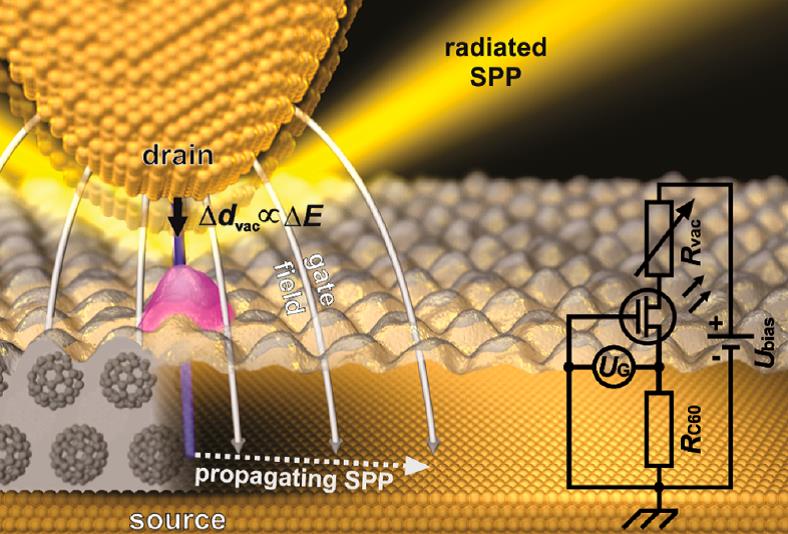 Controlling light at the nanoscale by electrical fields requires objects, in which electro-magnetic properties are responsive to gating fields. In two recent publications it was shown that molecules fulfil this requirement and act as such quantum transducers. This article was presented as research highlight in Nature Photonics. To read more see Nano Letters 2013 and Nano Letters 2014. Press Nature Photonics
Controlling light at the nanoscale by electrical fields requires objects, in which electro-magnetic properties are responsive to gating fields. In two recent publications it was shown that molecules fulfil this requirement and act as such quantum transducers. This article was presented as research highlight in Nature Photonics. To read more see Nano Letters 2013 and Nano Letters 2014. Press Nature Photonics
Electrically driven nuclear spin resonance in single-molecule magnets
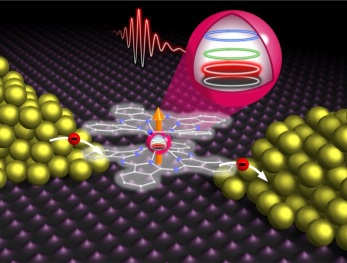 A recent publication in Science shows how coherent single nuclear-spin manipulation using electric fields only can be achieved. This quantum-mechanical process is present in all nuclear spin systems and uses of the hyperfine Stark effect as a magnetic field transducer at the atomic level. To read more see Science
A recent publication in Science shows how coherent single nuclear-spin manipulation using electric fields only can be achieved. This quantum-mechanical process is present in all nuclear spin systems and uses of the hyperfine Stark effect as a magnetic field transducer at the atomic level. To read more see Science
First Time Electronic Read-out of Nuclear Spin States
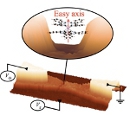 For the first time nuclear spin states could be read out electronically by integrating single quantum magnets into circuits
(in collaboration with W. Wernsdorfer). Long nuclear spin lifetimes (tens of seconds) and exceptional relaxation
characteristics at the single-atom scale open the way to a completely new device world, into which quantum logics may be
implemented. Nature. Press Nature Nanotech.
For the first time nuclear spin states could be read out electronically by integrating single quantum magnets into circuits
(in collaboration with W. Wernsdorfer). Long nuclear spin lifetimes (tens of seconds) and exceptional relaxation
characteristics at the single-atom scale open the way to a completely new device world, into which quantum logics may be
implemented. Nature. Press Nature Nanotech.
Real Space Observation of Spin-split Molecular Orbitals in Adsorbed SMMs
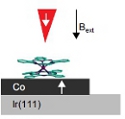 In collaboration with the group of R. Wiesendanger, the first direct real-space images of spin-split MOs at a TbPc2-Co(111)
spinterface were reported in Nature Comms
In collaboration with the group of R. Wiesendanger, the first direct real-space images of spin-split MOs at a TbPc2-Co(111)
spinterface were reported in Nature Comms
Coupling Single Molecule Magnets to Ferromagnetic Substrates
 The AF coupling of TbPc2 quantum magnets into a ferromagnetic substrate with observable remanescence up to 100 K was reported
in an article in Phys Rev Lett
The AF coupling of TbPc2 quantum magnets into a ferromagnetic substrate with observable remanescence up to 100 K was reported
in an article in Phys Rev Lett
Supramolecular Spin Valves
 The first demonstration of a fully functional spintronics device that is entirely made of molecular materials
is reported in two publications Nature Materials
and Nano Lett, More...
The first demonstration of a fully functional spintronics device that is entirely made of molecular materials
is reported in two publications Nature Materials
and Nano Lett, More...Press.
Scientific Scope
The research activity at the research unit "Molecular Materials" at the Karlsruhe Institute of Technology is oriented towards the design of functional nanosystems by state-of-the-art organic/inorganic synthesis and supramolecular self-assembly techniques for their implementation and integration into devices. The actual research the groups comprehends the following main topics:
Molecular spin qudits by isotopologue coordination chemistry
Molecules can be considered as physical Quantum Objects. The use of molecular materials represents the advantage that the
active quantum processing elements consist of an atomic core of one-to-few open spin ions surrounded by a shell of organic material.

At low temperature such molecular spin objects behave as simple, few-level systems and their spin degree of freedom can be sufficiently decoupled from the environment to achieve long decoherence times and making them to ideal candidates for the implementation of qubits. The first example of such successful realization of Molecular Quantum Spintronics, the completely electronic read out of a nuclear spin of a lanthanide ion (bearing electron and nuclear spins) embedded in a molecule (TbPc2), was recently reported in Nature. Herre van der Zant presented this article in the news and views section in Nature Nanotech.
Coherent spin-photon interfaces
Light can be used to operate quantum information processing systems, e.g. quantum computers and quantum networks, quickly and efficiently.
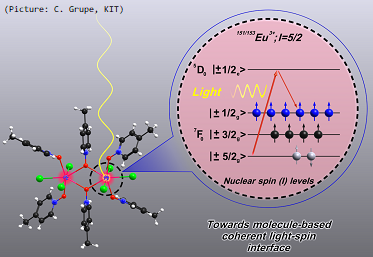
We have developed molecule-based materials suitable for use as light-addressable fundamental quantum units. By demonstrating for the first time light-induced spin polarization in the europium(III) molecule, we have succeeded in taking a promising step towards the development of quantum computing architectures based on rare-earth ion-containing molecules. As a test bed for connecting molecular qubits by coherent photons, a glas-fibre link has been recently inaugurated:

Operating quantum states in nuclear spin qudits
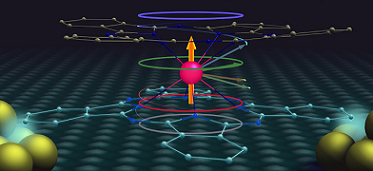
The successful implementation of Grover’s Quantum Algorithm into single molecule of TbPc2 for a quadratically accelerated search of an element in an unsorted data base, is described in the review. Andrea Morello presented this article in the news and views section in Nature Nanotech.
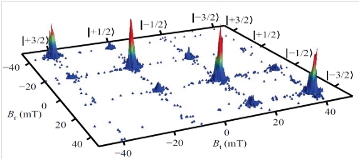
We demonstrared that the nuclear spin of an individual metal atom embedded in a single-molecule magnet can be read out electronically. The observed long lifetimes (tens of seconds) and relaxation characteristics of nuclear spin at the single-atom scale open the way to a completely new world of devices in which quantum logic may be implemented.
The spin associated with the single-molecule magnet is then subject to conservation of total angular momentum and energy, when attached to a CNT-mechanical nanoresonator.
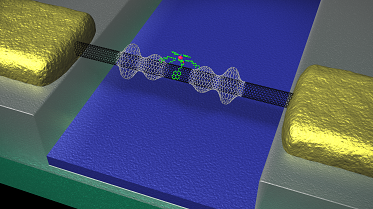
The observed long spin coherence life times concomitant with low-invasively electronic addressing, read out, and manipulation allow for the integration of magnetic molecules into electronic circuits and for the implementation of a quantum algorithms. Thus, metal complexes molecules show the potential to set the stage, in near future, to the novel class of quantum bits, the Molecular Spin QuBits.
Self-assembly for molecular devices
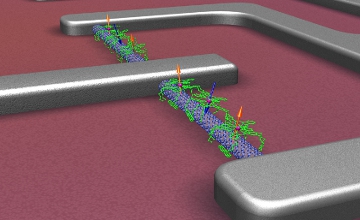
Breakthrough experiments have been carried out by the group targeting the self-assembly of spintronic devices. Supramolecular techniques were used to position magnetic molecules in defined device environments where single-spin addressing leads to the observation of magnetoresistive effects. The demonstrated possibility of manipulating spins at the single molecule limit opens a completely new world to Supramolecular Spintronic Devices, where memory, logic and possibly quantum logic may be integrated.
Surface-confined coordination chemistry

The vision of the research group is to develop new concepts and advance research tools to master the design and the characterisation of molecular structures as well as their implementation and integration within the nanometer-regime. Towards this end, the group is highly integrated into several interdisciplinary collaborations and is directing several interdisciplinary European network projects
Surface-Confined Molecular Motors
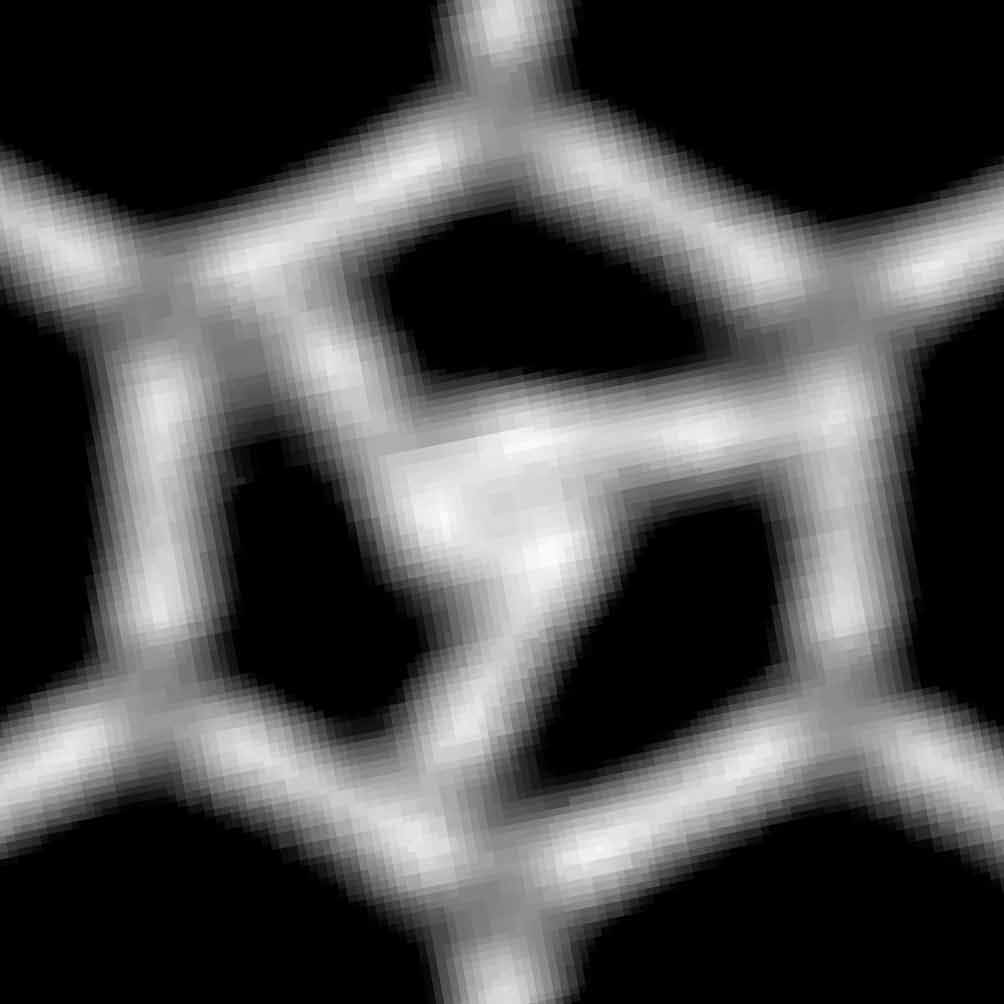 The self-assembly of surface-confined molecular motors from simple molecular building blocks was reported in the Proceedings of the National Academy
of Sciences (PNAS, in collaboration with J.V. Barth, TU München)
More....
The self-assembly of surface-confined molecular motors from simple molecular building blocks was reported in the Proceedings of the National Academy
of Sciences (PNAS, in collaboration with J.V. Barth, TU München)
More....
String Networks
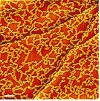 An article in Nature Chemistry reports on the random reticulation of a
metal surface by divergent
coordination assembly expressing string formation and bifurcation
motifs.
More....
An article in Nature Chemistry reports on the random reticulation of a
metal surface by divergent
coordination assembly expressing string formation and bifurcation
motifs.
More....
Dichotomous Array of Quantum Corrals
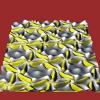
The confinement of surface-state electrons is possible using weak -interactions of aromatic molecules with metallic surfaces. The results obtained in collaboration with the group of J. V. Barth (TU Munich) demonstrate the engineering of ensembles of elaborate quantum resonance states by molecular self-assembly. More...
Expanding the Coordination Cage
 A Ruthenium(II)-polypyridine complex exhibiting high quantum yields
under ambient conditions was obtained by the expansion of the tpy
coordination cage.
More.....
A Ruthenium(II)-polypyridine complex exhibiting high quantum yields
under ambient conditions was obtained by the expansion of the tpy
coordination cage.
More.....
Switching Nanostructures
 The report on the
nanostructuring of switchable iron (II) spin transition compounds by
soft lithography techniques (in collaboration with M. Cavallini, CNR Bologna) was highlighted as "Hot Paper" in
Angewandte Chemie. More...
Press...
The report on the
nanostructuring of switchable iron (II) spin transition compounds by
soft lithography techniques (in collaboration with M. Cavallini, CNR Bologna) was highlighted as "Hot Paper" in
Angewandte Chemie. More...
Press...
Giant Magnetic Anisotropy SMMs
 The spin dynamics of a [TbPc2]-1-SMM
was probed by solid-state 1H NMR techniques. The magnetic anisotropy
barrier was found to be one order of magnitude larger than in any other
SMM system (584 cm-1 - 641 cm-1).
More
...
The spin dynamics of a [TbPc2]-1-SMM
was probed by solid-state 1H NMR techniques. The magnetic anisotropy
barrier was found to be one order of magnitude larger than in any other
SMM system (584 cm-1 - 641 cm-1).
More
...
Transport through a Single Metal Ion
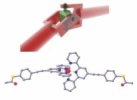
In collaboration with IBM, our group succeeded to study the electron transport through a single Ru(tpy)2-molecule. It was shown that the transport occurs in the resonant tunnelling regime and the ruthenium(II) metal ion behaves like the cross shaft in a Cardan-joint. More...
